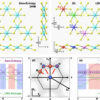Scientists from Durham University’s Chemistry Department have developed the world’s first laser scanning confocal microscope that can harness Circularly Polarized Light (CPL) to differentiate left and right-handed molecules, also known as chiral molecules.
The microscope, known as CPL Laser Scanning Confocal Microscope (CPL-LSCM), is the first of its kind that can detect and track luminescent chiral molecules in cells and has extensive potential to be used by the imaging and biomedical research community globally.
CPL Laser Scanning Confocal Microscope can track emissive chiral molecules within live cells and distinguish left-handed molecules from right-handed molecules that can emit bright light, which was not possible before.
Luminescent chiral molecules encode a unique optical fingerprint when emitting Circularly Polarized Light that contains information about the molecular environment, conformation, and binding state. For the first time ever, this information along with previously uncharted parts of biology and chemistry can be accessed and analyzed using the novel microscope.
The researchers also demonstrated that CPL-active probes can be activated using biologically favored low energy two-photon excitation that allows imaging of living tissues up to one millimeter in thickness, with complete CPL spectrum recovery.
Tracking of chiral molecules within live cells permits researchers to study the fundamental interactions between cell, organelles, drugs or introduced chiral molecular probes. This can be a great leap forward in many aspects of chemistry, biology and material science.
Full result of the study has been published in the journal Nature Communications.
Dr. Robert Pal, lead researcher of the study, said that “this is a significant milestone both in optical microscopy and circularly polarized luminescence research, and we hope that it will be adapted and used by many researchers world-wide to venture into the uncharted and study fundamental biological processes in a new ‘chiral’ light.”
The CPL Laser Scanning Confocal Microscope can simultaneously measure left and right-handed CPL, signifying a step forward in technological capability that opens up new opportunities to study chiral molecular interactions.
More information:
Patrycja Stachelek et al, Circularly polarised luminescence laser scanning confocal microscopy to study live cell chiral molecular interactions, Nature Communications (2022). DOI: 10.1038/s41467-022-28220-z
Citation:
Scientists invent world’s first advanced laser microscope to study chiral molecules (2022, February 1)



